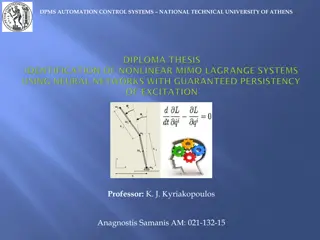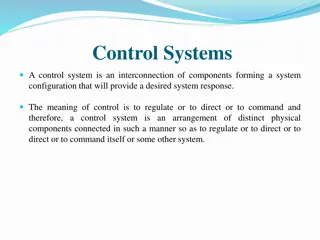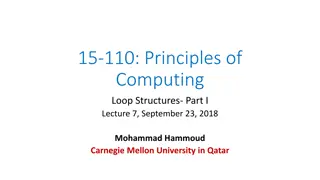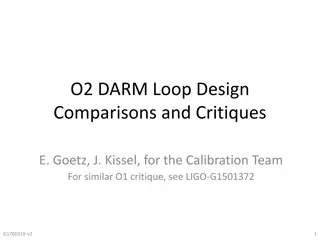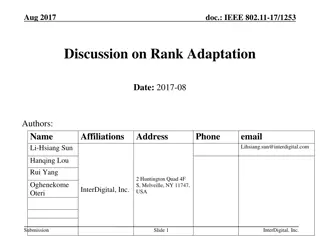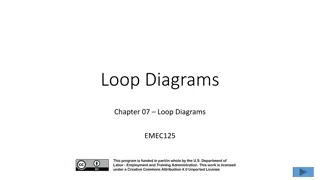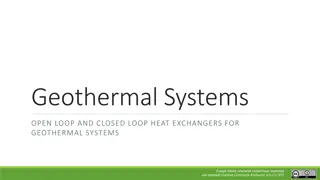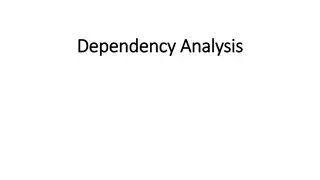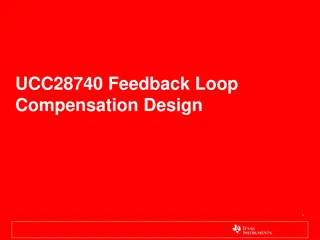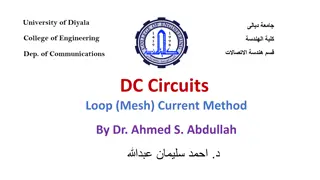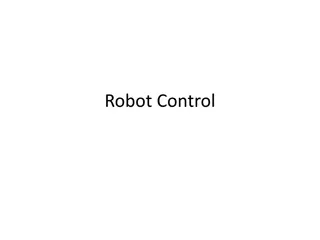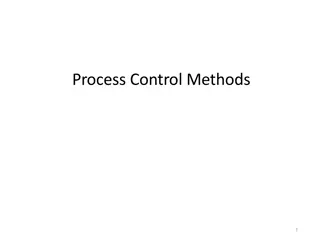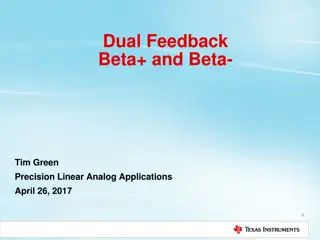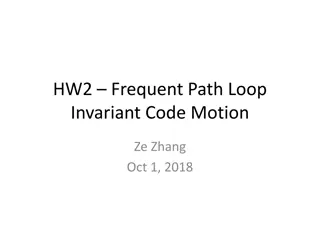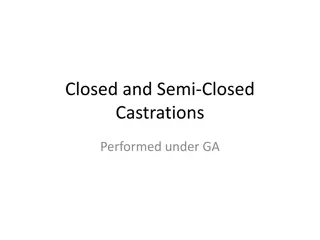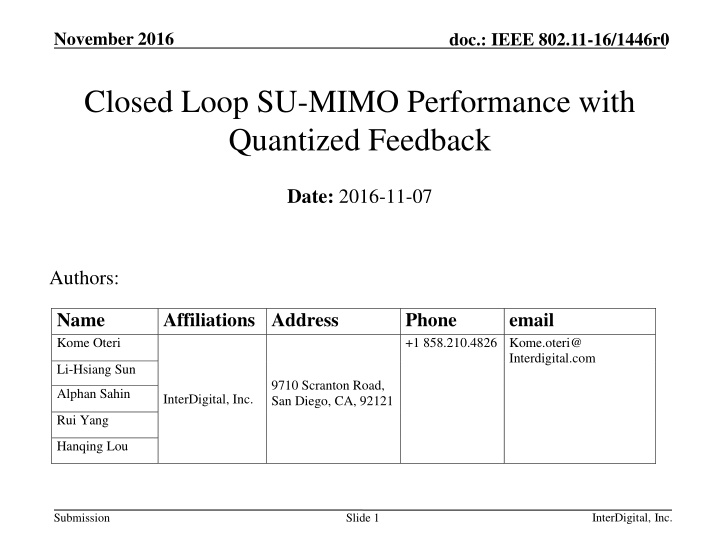
Enhancing SU-MIMO Performance in IEEE 802.11-16: Closed Loop Insights
Explore the improvements in Single User Multiple Input Multiple Output (SU-MIMO) transmissions within the IEEE 802.11-16 standard. Discover the benefits of Closed Loop SU-MIMO with quantized feedback compared to Open Loop SU-MIMO. Learn about baseband precoding methods and simulation assumptions for enhanced performance.
Download Presentation

Please find below an Image/Link to download the presentation.
The content on the website is provided AS IS for your information and personal use only. It may not be sold, licensed, or shared on other websites without obtaining consent from the author. If you encounter any issues during the download, it is possible that the publisher has removed the file from their server.
You are allowed to download the files provided on this website for personal or commercial use, subject to the condition that they are used lawfully. All files are the property of their respective owners.
The content on the website is provided AS IS for your information and personal use only. It may not be sold, licensed, or shared on other websites without obtaining consent from the author.
E N D
Presentation Transcript
November 2016 doc.: IEEE 802.11-16/1446r0 Closed Loop SU-MIMO Performance with Quantized Feedback Date: 2016-11-07 Authors: Name Kome Oteri Affiliations Address Phone +1 858.210.4826 Kome.oteri@ email Interdigital.com Li-Hsiang Sun 9710 Scranton Road, San Diego, CA, 92121 Alphan Sahin InterDigital, Inc. Rui Yang Hanqing Lou InterDigital, Inc. Submission Slide 1
November 2016 doc.: IEEE 802.11-16/1446r0 Introduction TGay has agreed that 11ay will support Single User Multiple Input Multiple Output (SU-MIMO) transmission [1] However, the agreement is based on Open Loop SU-MIMO (OL SU MIMO) only The 11ay specification shall support SU-MIMO with predetermined and/or no precoding matrices [1] The 11ay specification shall define SU-MIMO transmission with and without phase hopping of EDMG-PPDU for EDMG OFDM PHY. An EDMG STA may support transmission and reception of SU-MIMO with phase hopping With/without precoding is TBD; Period of phase hopping is TBD In [2] and [6], we have shown the performance gains of Closed Loo SU-MIMO (CL SU-MIMO) with ideal feedback over OL SU-MIMO In this contribution, we show the BER performance of CL SU-MIMO with quantized feedback over OL SU-MIMO. The quantized feedback is based on the 802.11ad BRP feedback framework, InterDigital, Inc. Submission Slide 2
November 2016 doc.: IEEE 802.11-16/1446r0 Baseband Precoding Methods Open loop: Use the first Nss columns of an orthogonal matrix as a precoding matrix across all antennas* No channel knowledge needed at transmitter Closed loop with Ideal Feedback: Use SVD based on the time domain channel matrix of the strongest path Full Channel State Information (CSI) knowledge at transmitter Closed loop with Quantized Feedback: Use SVD based on the time domain channel matrix of the strongest path Quantized Channel State Information (CSI) knowledge at transmitter * One PAA with dual polarization is considered as two antennas InterDigital, Inc. Submission Slide 3
November 2016 doc.: IEEE 802.11-16/1446r0 Simulation Assumptions Based on 11ad SC PHY 2 spatial streams with spatial stream parser Vertical Encoding 25 meter 1.8 m MCS index is the same for all streams per PPDU, single CRC per PPDU MMSE receiver Enterprise Cubicle (CB) scenario in 11ay/ad channel model STAs located on the table at a height of 0.7m in the cubicle AP positioned in the middle below the ceiling at a height of 2.9 m Real channel estimation at receiver Detailed assumptions can be found in the appendix STA2 STA1 2.5 m STA3 Cubicle 8 Cubicle 7 1.0 m Cubicle 5 Cubicle 6 1.0 m AP in ceiling Cubicle 4 Cubicle 3 Cubicle 1 Cubicle 2 y 0 1.0 m x 0 25 meter InterDigital, Inc. Submission Slide 4
November 2016 Simulated SU-MIMO Configurations doc.: IEEE 802.11-16/1446r0 Beamforming implemented in all configurations Analog beamforming: Using phase shifter at each antenna to align Tx and Rx beams Digital beamforming: Spatial streams are precoded (as described in slide Baseband Precoding Methods ) and distributed to all antennas We simulate Configuration #4 of the SU-MIMO PAA configurations [3] 4x4 channel, 2 PAAs with dual polarization on each side InterDigital, Inc. Submission Slide 5
November 2016 doc.: IEEE 802.11-16/1446r0 Quantized Feedback Assume Enhanced BRP feedback used to estimate effective channel BRP feedback based on the effective MIMO channel. 11ad type BRP feedback modified for 11ay MIMO Channel Each channel tap is reported as an in-phase and quadrature component pair, with each component value represented as a twos complement number between 128 and 127. Example: 0.2791 + 0.1297i 0.0671 + 0.0316i 0.2849 - 0.1880i 0.0597 - 0.0394i -0.0731 - 0.0339i 0.3423 + 0.1600i -0.0596 + 0.0394i 0.2849 - 0.1880i -0.0254 + 0.3488i -0.0012 + 0.0161i -0.1400 - 0.3599i -0.0313 - 0.0805i 0.0012 - 0.0161i -0.0254 + 0.3487i 0.0283 + 0.0728i -0.1141 - 0.2933i 98 + 46i 24 + 11i 101 - 66i 21 - 14i -26 - 12i 121 + 56i -21 + 14i 101 - 66i -9 + 123i 0 + 6i -49 - 127i -11 - 28i 0 - 6i -9 + 123i 10 + 26i -40 - 103i InterDigital, Inc. Submission Slide 6
November 2016 doc.: IEEE 802.11-16/1446r0 Conf #4, Nss=2 Observations: CL better than open loop Loss using quantized (realistic) feedback is minimal due to the 8-bit quantization per complex dimension InterDigital, Inc. Submission Slide 7
November 2016 doc.: IEEE 802.11-16/1446r0 Conclusion The performance of CL SU MIMO is better than OL SU MIMO CL SU MIMO however requires additional overhead in the form of feedback A simple extension of 11ad BRP element feedback can support CL SU-MIMO with minimal loss when compared with ideal feedback Note that further optimization of the feedback may be possible. InterDigital, Inc. Submission Slide 8
November 2016 doc.: IEEE 802.11-16/1446r0 References 1. Carlos Cordeiro, Specification Framework for TGay , IEEE 802.11- 15/01358r4 Rui Yang, et al, Open Loop vs Closed Loop SU-MIMO for 11ay , IEEE doc. 11-15/0642r1 A. Maltsev, et al, Channel models for ieee 802 11ay , IEEE doc. 11- 15/1150r4 R. Maslennikov, et al, Implementation of 60 GHz WLAN Channel Model, IEEE doc. 11-10/0854r3. Artyom Lomayev, et al, EDMG STF and CEF Design for SC PHY in 11ay , IEEE doc. 11-16/0994r1 L. Sun, et al, Link Level Performance Comparisons of Open Loop, Closed Loop and Antenna Selection for SU-MIMO 11-16/0911r1 2. 3. 4. 5. 6. InterDigital, Inc. Submission Slide 9
November 2016 doc.: IEEE 802.11-16/1446r0 Straw Poll Do you agree to insert the following in clause 7 of the SFD: The 11ay specification shall support SU-MIMO with matrices derived from channel feedback InterDigital, Inc. Submission Slide 10
November 2016 doc.: IEEE 802.11-16/1446r0 APPENDIX InterDigital, Inc. Submission Slide 11
November 2016 doc.: IEEE 802.11-16/1446r0 Channel parameters For channel with LOS components [3], TX/RX analog beamforming for both polarizations of PAA#i are based on the LOS direction between TX PAA#i RX PAA#i For channel without LOS components Beam forming based on the AoD/AoA of strongest signal path between TX PAA#i RX PAA#i Channel bandwidth 2.64 GHz, center frequency 60.48 GHz Each PAA has 16 elements (8 X 2) Distance between antenna elements 0.0025m Distance between center of PAAs 10cm For AP-STA scenario, STA is placed at a plane 2m below AP in the cubicle 1. Random rotation around z-axis between STA/AP. InterDigital, Inc. Submission Slide 12



